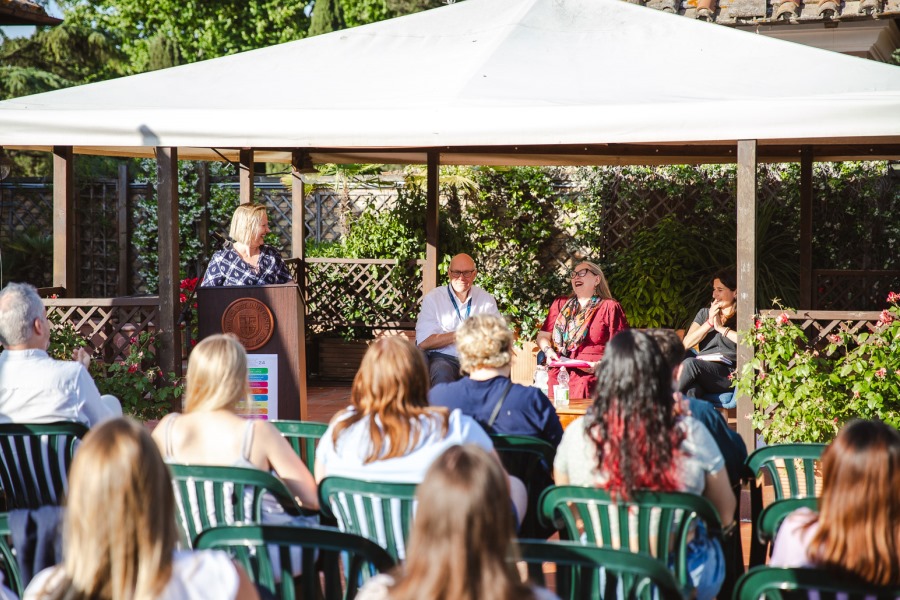IFE Welcomes Federico Monica for a Talk on Urbanization in Africa
The John Cabot University Institute for Entrepreneurship welcomed Federico Monica, architect, urban planner, and founder of Placemarks Africa, for a talk called “Urbanization in Africa: Future Social, Cultural and Environmental Implications for Africans,” on January 26, 2022. The talk was the first in the ‘Anima Mundi’ – Global Business Perspectives Guest Lecture Series organized by Professor Ieva Jākobsone Bellomi and was held in the context of her ‘International Management’ class.
Monica is the founder of Placemarks Africa, a project that analyzes satellite images to assess the changes in landscape, environment, and ecosystems across Africa. Placemarks’ mission is to raise awareness of environmental and social changes that are taking place in Africa, with a focus on best practices, reporting issues, and helping to design solutions.

Federico Monica
Monica started by giving an overview of the continent, which is composed of 54 countries, 1.2 billion people, and 30,3 million square kilometers, accounting for one-fifth of the global population and surface. Before starting his presentation, Monica said that there are some constraints to data accuracy. He explained that the data might be affected by the high growth rates, the different methods used to gather them, the difficulty in collecting them in some areas, and the instability that characterizes parts of the continent.
Growth rate and “urban sprawl”
He then went on to give a more detailed picture of African cities and started by saying that in the past sixty years urbanization rates in Africa (mainly sub-Saharan) have increased dramatically. In 1960, 40 million people (15% of the African population) lived in urban areas, and by 2020 this number had increased to 600 million (50% of the African population). Monica explained that urban areas can be classified as megalopolis, big cities, and small and medium-sized cities. The African continent has 14 megalopolis (with over five million inhabitants each), 27 big cities (with over 2.5 million inhabitants each), and 7,500 small and medium sized cities (from 10 thousand to 300 thousand inhabitants each), and that respectively 12%, 17%, and 48% of the continent’s population lives in one of these cities.
Monica also talked about the issues that urbanization brings about. He said that Africa’s average urban growth rate of 4% is very high and therefore makes it difficult to adopt “traditional” urban planning techniques, which require more time to implement. In fact, a megalopolis usually gets around 200 thousand new residents each year. Lagos (Nigeria), the most populous city of Africa, welcomes 1950 new residents each day. He explained that given the very high growth rates, African cities tend to develop and grow horizontally rather than vertically, in what’s known as “urban sprawl.” The vastity of the cities then makes it difficult to build infrastructures and increases the maintenance costs.
Monica gave the example of Cotonou, Benin’s largest city, and showed a satellite picture that depicts the coastal area full of stilt houses. He explained that the population of the city increases at such a rate that its inhabitants are forced to come up with creative ways to find/build a shelter.
Infrastructural challenges
Monica continued by mentioning the infrastructural problems that arise from Africa’s very high growth rate. He said that in terms of access to water, only 34% of the urban population has a private source available, whereas 40% must rely on public fountains. As for energy, 25 to 60% of the urban population doesn’t have access to the power grid. He explained that the increasing demand for power, the unreliability of the connections, and the frequent blackouts brought about emergency solutions such as the use of power ships (ships that has been modified to have a power plant installed on them and that serve as power generation resources). He added that 75% of the power is generated through fossil fuels, negatively impacting the environment.
Regarding the sewage system, only 32% of the urban population has access private toilets, and those who don’t, have to pay to access public ones. In terms of waste, Monica explained that 70% of it is disposed in open landfills, but he also said that 8 to 10% of waste is recycled through informal activities.
Monica also talked about informality and said that in Africa it is not a problem but that it often is actually the answer/solution. He reminded the audience that informality is different from illegality, and that although the latter might be an aspect of some informal communities, it is wrong to assume that the two are equal. He then said that 55% of urban residents (350 million people) live in informal settlements or slums. Monica explained that in order for an area to be classified as slum, it needs to have at least one of the following characteristics: lack of basic services, high density, lack of tenure rights, risky areas, and low standard buildings. He also invited students to understand that despite slums’ external appearance, the houses’ interiors are actually very clean and well kept.
Monica concluded by highlighting some lessons that could be learned from African cities. He encouraged people to be flexible, adaptable, and ready to change. He added that it’s important to look beyond the surface, and that the Western world’s solutions and theories are not the only ones that are possible to implement or that necessarily work best.
Federico Monica holds a Ph.D. in Urban Planning with a specialization in African cities from the Università degli Studi di Parma. He is a consultant for NGOs and International Organizations in the fields of urban assessment and planning, environmental assessment, architectural design, and building process.





